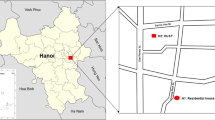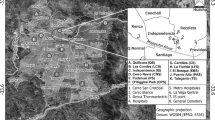Abstract
Nablus city is an important urban and industrial center in the West Bank, Palestine. The topography of the city, combined with multiple sources of air pollution, creates a potential air quality problem that might affect human health. The indoor and outdoor particle concentration distributions of PM10, PM5.0, PM2.5, and PM1.0 were measured using a Grimm aerosol spectrometer from December 2014 to November 2015, at four roadsides and four urban homes in Nablus. The results of the annual averages of PM10 and PM2.5 concentrations were found to be at least three times higher than that of the European Air Quality Standards both in indoors and outdoors. The difference in the results between both the roadside and the urban areas was attributed to human and industrial activities in Nablus. The results revealed that the highest concentrations of the particulate matters are during summer, especially June and July, in the roadside areas due to heavy industrial activities during these months. The same behavior was noticed for urban areas during summer and due to other human activities. The results of indoor/outdoor (I/O) ratios were found to be less than, but very close to, 1 for both roadside and urban areas in summer and winter months. In winter times, areas with poor ventilation indicated the existence of additional sources of PM within the indoor environments, especially when smoking cigarettes and using fuel-based heaters such as fireplaces gas and kerosene heaters.




Similar content being viewed by others
References
Akbari M, Samadzadegan F (2015) Identification of air pollution patterns using a modified fuzzy co-occurrence pattern mining method. Int J Environ Sci Technol 12(11):3551–3562
Ashmore MR, Dimitroulopoulou C (2009) Personal exposure of children to air pollution. Atmos Environ 43:128–141
Bang HQ, Khue HN, Tam NT et al (2017) Air pollution emission inventory and air quality modeling for Can Tho City, Mekong Delta, Vietnam. Air Qual Atmos Health. https://doi.org/10.1007/s11869-017-0512-x
Błaszczyk E, Kozłowska WR, Klejnowski K, Kubiesa P, Fulara L, Mielżyńska-Švach D (2017) Indoor air quality in urban and rural kindergartens: short-term studies in Silesia, Poland. Air Qual Atmos Health. https://doi.org/10.1007/s11869-017-0505-9
Bu-Olayan A, Thomas B (2016) Combined effects of particulates dispersion and elemental analysis in desert plants: a modeling tool to air pollution. Int J Environ Sci Technol 13(5):1299–1310
Byrne MA (1998) Aerosols exposed. Chem Br (R Soc Chem) 1998:23e6
Chao C, Tung T, Burnett J (1998) Influence of different indoor activities on the indoor particulate levels in residential buildings. Indoor Built Environ 7(2):110–121
Dincer N, Yalçin M (2016) Revealing information and equipment redundancies in air pollution monitoring networks in Turkey. Int J Environ Sci Technol 13(12):2927–2938
Dockery D, Spengler J (1981) Indoor-outdoor relationships of respirable sulfates and particles. Atmos Environ 15(3):335–343
Ganick NR, Gobbell RV, Hays SM (1995) Indoor air quality: solutions and strategies. McGraw-Hill Inc., New York
Geller M, Chang M, Sioutas C, Ostro B, Lipsett M (2002) Indoor/outdoor relationship and chemical composition of fine and coarse particles in the southern California deserts. Atmos Environ 36(6):1099–1110
Giri D, Murthy K, Adhikary P, Khanal S (2006) Ambient air quality of Kathmandu valley as reflected by atmospheric particulate matter concentrations (PM10). Int J Environ Sci Technol 3(4):403–410
Giri D, Murthy V, Adhikary P, Khanal S (2007) Estimation of number of deaths associated with exposure to excess ambient PM10 air pollution. Int J Environ Sci Technol 4(2):183–188
Guinot B, Cachier H, Sciare J, Tong Y, **n W, Jianhua Y (2007) Bei**g aerosol: atmospheric interactions and new trends. J Geophys Res 112(D14):928–935
Hoek G, Kos G, Harrison R, Hartog J, Meliefste K, Brink H, Katsouyanni K, Karakatsani A, Lianou M, Kotronarou A, Kavouras I, Pekkanen J, Vallius M, Kulmala M, Puustinen A, Thomas S, Meddings C, Ayresi J, van Wijnen J, Hameri K (2008) Indoor-outdoor relations of particle number and mass in four European cities. Atmos Environ 42:156-169
Howard-Reed C, Wallace L, Ott W (2002) The effect of opening windows on air change rates in two homes. J Air Waste Manage Assoc 52(2):147–159
Huang H, Cao JJ, Lee SC, Zou CW, Chen XG, Fan SJ (2007) Spatial variation and relationship of indoor/outdoor PM2.5 at residential homes in Guangzhou city, China. Aerosol Air Qual Res 7:518–530
Jiang Q, Christakos G (2017) Space-time map** of ground-level PM2.5 and NO2concentrations in heavily polluted northern China during winter using the Bayesian maximum entropy technique with satellite data. Air Qual Atmos Health:1–11. https://doi.org/10.1007/s11869-017-0514-8
Kamens R, Lee C, Wiener R, Leith D (1991) A study of characterize indoor particles in three non-smoking homes. Atmos Environ Part A 25(5–6):939–948
Klepeis NE, Nelson WC, Ott WR, Robinson JP, Tsang AM, Switzer P, Behar JV, Hern SC, Engelmann WH (2001) The national human activity pattern survey (NHAPS): a resource for assessing exposure to environmental pollutants. J Expo Anal Env Epid 11:231–252
Lai A (2002) Particle deposition indoors: a review. Indoor Air 12(4):211–214
Lee JY, Ryu SH, Lee G, Nam Bae G (2016) Indoor-to-outdoor particle concentration ratio model for human exposure analysis. Atmos Environ 127:100–106
Li CS, Lin CH (2003) Carbon profile of residential indoor PM1.0 and PM2.5 in the subtropical region. Atmos Environ 37:881–888
Mantis J, Chaloulakou A, Samara C (2005) PM10-bound polycyclic aromatic hydrocarbons (PAHs) in the greater area of Athens, Greece. Chemosphere 59(5):593–604
Massey D, Kulshrestha A, Masih J, Taneja A (2012) Seasonal trends of PM10, PM5.0, PM2.5, PM1.0 in indoor and outdoor environments of residential homes located in North Central India. Build Environ 47:223–231
Massey D, Masih J, Kulshrestha, Habil M, Taneja A (2009) Indoor/outdoor relationship of fine particles less than 2.5 um (PM 2.5) in residential homes locations in central Indian region. Build Environ 44:2037–2045
Massey D, Habil M, Taneja A (2013a) Exposure of children studying in schools of India to PM levels and metal contamination: sources and their identification. Air Qual Atmos Health 6(3):575–587
Massey D, Kulshrestha A, Taneja A (2013b) Particulate matter concentrations and their related metal toxicity in rural residential environment of semi-arid region of India. Atmos Environ 67:278–286
Massey D, Habil M, Taneja A (2016) Particles in different microenvironments—its implications on occupants. Build Environ 106:237–244
Modarres R, Dehkordi A (2005) Daily air pollution time series analysis of Isfahan City. Int J Environ Sci Technol 2(3):259–267
Mohammadyan M, Ghoochani M, Kloog I, Abdul-Wahab SA, Yetilmezsoy K, Heibati B, Pollitt KG (2017) Assessment of indoor and outdoor particulate air pollution at an urban background site in Iran. Environ Monit Assess 189:235. https://doi.org/10.1007/s10661-017-5951-1
Monn C, Fuchs A, Högger D, Junker M, Kogelschatz D, Roth N, Wanner H (1997) Particulate matter less than 10 μm (PM10) and fine particles less than 2.5 μm (PM2.5): relationships between indoor, outdoor and personal concentrations. Sci Total Environ 208(1–2):15–21
NAAQS (2009) The gazette of India, Ministry of Environmental and Forests Notification. National ambient air quality standards e NAAQS: vol. 16
Oosterlee A, Drijver M, Lebret E, Brunekreef B (1996) Chronic respiratory symptoms in children and adults living along streets with high traffic density. Occup Environ Med 53(4):241–247
Palestinian Central Bureau of Statistics (PCBS) (2015) on the eye of the world elderly day. https://www.pcbs.gov.ps/portals/_pcbs/PressRelease/Press_En_WElderlyD2015E.pdf. Accessed 26 July 2017
Palestinian Central Bureau of Statistics (PCBS) (2009) Census final results—summary (population, buildings, housing, establishments) Nablus Governorate
Perišić M, Maletić D, Stojić S, Rajšić S, Stojić A (2016) Forecasting hourly particulate matter concentrations based on the advanced multivariate methods. Int J Environ Sci Technol 14(5):1047–1054
Poupard O, Blondeau P, Iordache V, Allard F (2005) Statistical analysis of parameters influencing the relationship between outdoor and indoor air quality in schools. Atmos Environ 39:2071–2080
Shakerkhatibi M, Dianat I, Asghari Jafarabadi M, Azak R, Kousha A (2015) Air pollution and hospital admissions for cardiorespiratory diseases in Iran: artificial neural network versus conditional logistic regression. Int J Environ Sci Technol 12(11):3433–3442
Silva L, Pinho J, Nurusman H (2014) Traffic air pollution monitoring based on an air–water pollutants deposition device. Int J Environ Sci Technol 11(8):2307–2318
Simkhada K, Murthy K, Khanal S (2005) Assessment of ambient air quality in Bishnumati corridor, Kathmandu metropolis. Int J Environ Sci Technol 2(3):217–222
Smith KR, Jantunen M, Goldstein BD (2002) Methodologies of assessing exposure to combustion products: particles and their semi-volatile constituents, special issue. Chemosphere 49(9):865–1190
Stazi F, Naspi F, Ulpiani G, Di Perna C (2017) Indoor air quality and thermal comfort optimization in classrooms develo** an automatic system for windows opening and closing. Energ Buildings 139:732–746
Steinemann A, Wargocki P, Rismanchi B (2017) Ten questions concerning green buildings and indoor air quality. Build Environ 112:351–358
Taneja A, Saini R, Masih A (2008) Indoor air quality of houses located in the urban environment of Agra, India. Ann N Y Acad Sci 1140(1):228–245
Thatcher T (1995) Deposition, resuspension, and penetration of particles within a residence. Atmos Environ 29(13):1487–1497
WeatherSpark.com (2017) Retrieved June 29, 2017, from https://weatherspark.com/y/98966/Average-Weather-in-Nablus-Palestinian-Territories
WHO (1987) Air quality guidelines for Europe. World Health Organization. Geneva. Ser. No. 23–1987
Wiley, J.A., Robinson, J.P., Piazza, T., Garrett, K., Cirksena, K., Cheng, Y.T., Martin, G. (1991) Activity patterns of California residents. California Air Resources Board. Final reports No. A6e177-33
Zhao W, Cheng J, Yu Z, Tang Q, Cheng F, Yin Y, Wang W (2013) Levels, seasonal variations, and health risks assessment of ambient air pollutants in the residential areas. Int J Environ Sci Technol 10(3):487–494
Acknowledgements
The authors would like to thank the French Government for their support (ENVIMED iv 2015) and both An-Najah National University Department of Geography and Nablus Broadcasting Weather Station for hel** us about broadcasting the weathers and supplying us with weather temperatures and humidities. Also, many thanks go to the Palestinian Ministry of Local Municipalities for supporting us financially to do this work.
Author information
Authors and Affiliations
Corresponding authors
Rights and permissions
About this article
Cite this article
Jodeh, S., Hasan, A.R., Amarah, J. et al. Indoor and outdoor air quality analysis for the city of Nablus in Palestine: seasonal trends of PM10, PM5.0, PM2.5, and PM1.0 of residential homes. Air Qual Atmos Health 11, 229–237 (2018). https://doi.org/10.1007/s11869-017-0533-5
Received:
Accepted:
Published:
Issue Date:
DOI: https://doi.org/10.1007/s11869-017-0533-5




